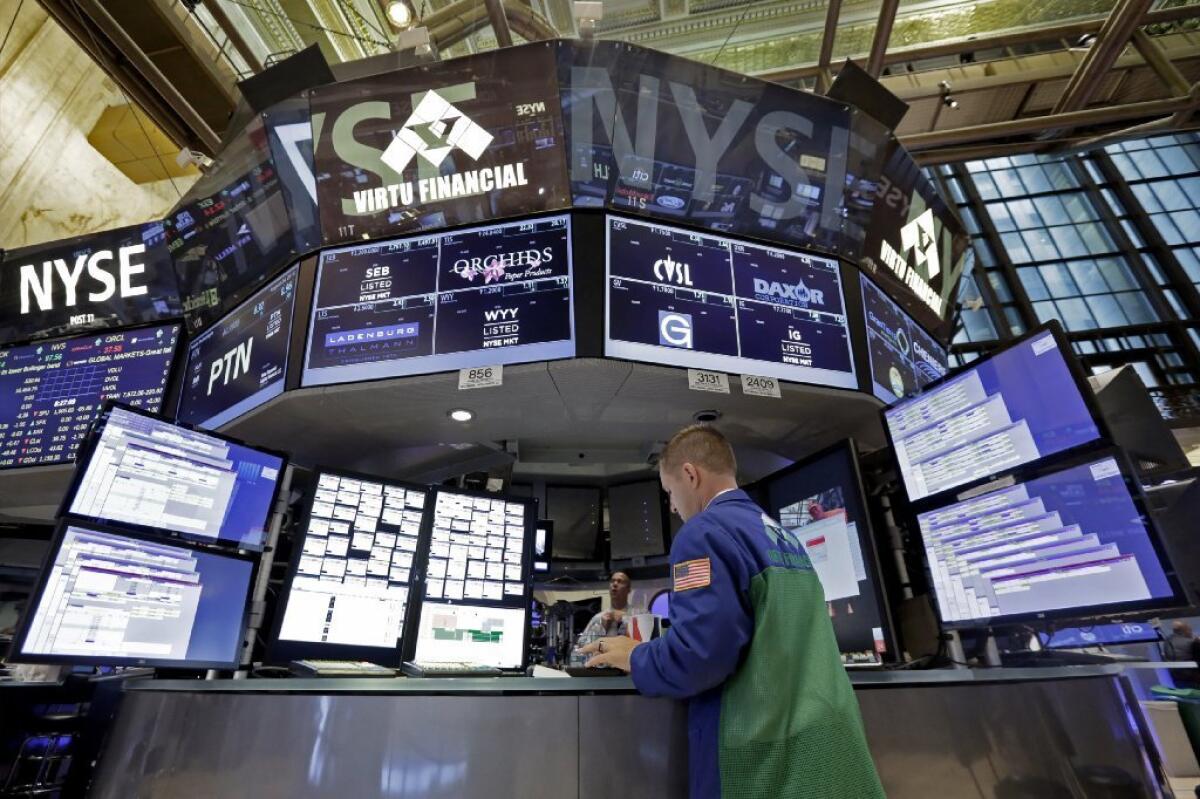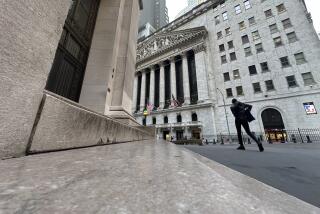Big losses on Wall Street leave investors wondering what’s next

Specialist David Vadala prepares for the day’s trading on the floor of the New York Stock Exchange on Monday. The Dow Jones industrial average closed with a loss of 588.47 points, or down about 3.6%.
- Share via
Moments after the U.S. stock market opened Monday, anyone checking prices might have rubbed their eyes in disbelief: The Dow Jones industrial average had plunged nearly 1,100 points.
“A four-digit decline is enough to wake people out their morning slumber,” said Bruce Simon, chief investment officer at City National Rochdale, an investment arm of City National Bank in Los Angeles.
Then, only minutes later, the market launched a furious comeback as investors’ sentiment shifted on a dime, and within three hours the market erased most of its losses. But the rally ran out of gas.
When the chaotic trading day ended, stocks remained above their day’s lows but had suffered major losses for the third consecutive session — leaving investors wondering what carnage may lie ahead.
“It’s too soon to tell which way we’re headed,” said Mark Luschini, chief investment strategist at Janney Montgomery Scott.
After another round of market sell-offs worldwide, sparked again by losses in China, the Dow closed with a loss of 588.40 points, or 3.6%, to 15,871.35. It was the index’s eighth-worst point drop in history.
The Dow is now down 13.3% from its record high of 18,312.39 set May 19. That’s well within what Wall Street calls a correction, a loss of 10% or more from a recent high.
Other key indexes also fell into correction territory. Standard & Poor’s 500 index tumbled 3.9% on Monday and was off 11.2% from its record high. The Nasdaq composite index dropped 3.8% and also was down 13.3% from its peak.
Based on the broad-based Wilshire 5000 index, the declines over the last three sessions have wiped out $2.2 trillion of U.S. stock market value.
Stung by those losses and whipsawed by Monday’s turbulent session, about the only certainty investors have is uncertainty about whether the roller-coaster ride will end soon.
Monday’s crazy day also left them facing at least two key questions:
When the market soared from its opening plunge, was that a sign of underlying strength and attractive stock values that could mean higher prices ahead?
Or was the rally just a temporary upswing that Wall Street coarsely calls a “dead cat bounce,” one that often involves traders buying stocks simply to cover earlier short sales when they bet prices would fall?
Some analysts took the bullish side and said it showed the market’s resilience.
“We’re in a volatile market, and these pullbacks are going to occur,” said Michael Kanigher, a managing director and private wealth advisor at UBS. Despite its recent losses, “the market seems to be doing well and [is] definitely not on a path to a recession, and because of that, we expect the market to go higher.”
So does Simon, whose firm has $28 billion under management. “We still think it will be a reasonably good year when all is said and done,” with major indexes in the black for the year, he said.
No one piece of news has sparked the market’s rout. Rather, several factors pushed investors to sell in droves in recent days, led by concern that China’s economy — the second largest behind the United States’ — is facing a more serious slowdown than many had expected.
Those factors came against the backdrop of stocks riding a six-year bull market and prices long overdue for a correction, which many view as a necessary breather to keep propelling prices higher.
Indeed, the S&P 500 closed Friday trading at 21.6 times its member companies’ profits for the last 12 months, well above the historical average of 15.5, according to the research firm Birinyi Associates.
“The problem was [stock] valuations that had gotten to the point where there wasn’t much upside left,” Simon said. “There needed to be a bit of blowing off steam.”
Investors’ fears about China were exacerbated by China’s recent decision to devalue its currency and by the sell-off in Chinese stocks.
China’s key stock index, the Shanghai composite, plunged 8.5% on Monday, erasing its gains for the year and triggering market declines elsewhere around the world. Even so, the index is still up 43.3% in the last 12 months.
In Europe, the Stoxx Europe 50 index fell 5.6% and Germany’s DAX index was off 4.7%. Japan’s Nikkei 225 fell 4.6%.
And as those markets dropped, the stockpile of sell orders building ahead of U.S. trading mushroomed.
“There was pent-up [sell] emotion over the weekend, particularly from individual investors,” said Chris Bertelsen, chief investment officer at Global Financial Private Capital.
So when U.S. trading opened, prices immediately plummeted. “It took on a crescendo feeling,” Janney’s Luschini said.
Investors also are uncertain about whether the Federal Reserve will lift its benchmark U.S. interest rate next month from its current low of near zero, an outlook that’s grown even murkier with the markets’ decline.
Wall Street will get more signals about the state of the U.S economy this week with the release of reports that include new home sales in July, consumer confidence this month and a possible revision of the second-quarter’s estimated economic growth, which previously was pegged at an annual rate of 2.3%.
“Obviously people are concerned or nervous” with the market’s sell-off, Simon said. “But we haven’t been deluged with calls from clients saying, ‘Get me out.’ Most of them actually are looking at this as a buying opportunity.”
Perhaps, but it could be a rough ride in the meantime. That was true Monday for such widely held stocks as Apple Inc.
After closing Friday at $105.76 a share, Apple plunged to $92 at the opening, then rallied as high as $108.80 a share before dropping again and closing with a loss of $2.64, or 2.5%, to $103.12.
Traders looking for an alternative to stocks bid up Treasury bond prices, sending their yields lower. The yield on the 10-year Treasury bond fell below 2% — to 1.96% — for the first time since April, but ended the day at 2%, down from 2.05%.
Amid fears of global economic weakness, crude-oil prices tumbled below $40 a barrel for the first time since the economic crisis in early 2009. Light crude for near-term delivery fell $2.21, or 5.5%, to $38.24 a barrel on the New York Mercantile Exchange.
The euro climbed against the dollar to $1.16 from $1.14.
Twitter: @PeltzLATimes
Times staff writer Samantha Masunaga contributed to this report.
More to Read
Inside the business of entertainment
The Wide Shot brings you news, analysis and insights on everything from streaming wars to production — and what it all means for the future.
You may occasionally receive promotional content from the Los Angeles Times.











